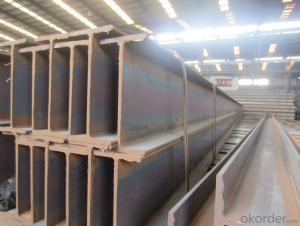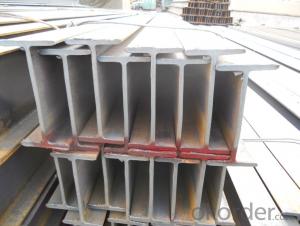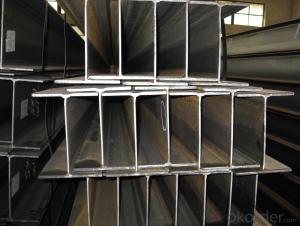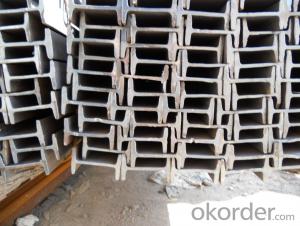Hot Rolled Structual Carbon JIS Steel H-beam Bar
- Loading Port:
- China main port
- Payment Terms:
- TT or LC
- Min Order Qty:
- 25 m.t.
- Supply Capability:
- 1000 m.t./month
OKorder Service Pledge
OKorder Financial Service
You Might Also Like
Product Description:
OKorder is offering high quality Hot Rolled Steel I-Beams at great prices with worldwide shipping. Our supplier is a world-class manufacturer of steel, with our products utilized the world over. OKorder annually supplies products to European, North American and Asian markets. We provide quotations within 24 hours of receiving an inquiry and guarantee competitive prices.
Product Applications:
Commercial building structure ;Pre-engineered buildings; Machinery support structure; Prefabricated structure; Medium scale bridges; Ship-building structure.etc.
Product Advantages:
OKorder's Steel I-Beams are durable, strong, and resist corrosion.
Main Product Features:
· Premium quality
· Prompt delivery & seaworthy packing (30 days after receiving deposit)
· Corrosion resistance
· Can be recycled and reused
· Mill test certification
· Professional Service
· Competitive pricing
Product Specifications:
Manufacture: Hot rolled
Grade: Q195 – 235
Length: 6m – 12m, as per customer request
Packaging: Export packing, nude packing, bundled
H x B
(mm)
| T1 | T2 | JIS Weight
(kg/m)
| GB Weight
(kg/m)
|
100*100 | 6 | 8 | 16.9 | 17.2 |
125*125 | 6.5 | 9 | 23.6 | 23.8 |
150*75 | 5 | 7 | 14 | 14.3 |
148*100 | 6 | 9 | 20.7 | 21.4 |
150*150 | 7 | 10 | 31.1 | 31.9 |
175*90 | 5 | 8 | 18 | 18.2 |
175*175 | 7.5 | 11 | 40.4 | 40.4 |
198*99 | 4.5 | 7 | 17.8 | 18.5 |
200*100 | 5.5 | 8 | 20.9 | 21.7 |
194*150 | 6 | 9 | 29.9 | 31.2 |
200*200 | 8 | 12 | 49.9 | 50.5 |
248*124 | 5 | 8 | 25.1 | 25.8 |
250*125 | 6 | 9 | 29 | 29.7 |
244*175 | 7 | 11 | 43.6 | 44.1 |
250*250 | 9 | 14 | 71.8 | 72.4 |
298*149 | 5.5 | 8 | 32 | 32.6 |
298*201 | 9 | 14 | 65.4 | |
300*150 | 6.5 | 9 | 36.7 | 37.3 |
294*200 | 8 | 12 | 55.8 | 57.3 |
300*300 | 10 | 15 | 93 | 94.5 |
346*174 | 6 | 9 | 41.2 | 41.8 |
350*175 | 7 | 11 | 49.4 | 50 |
340*250 | 9 | 14 | 78.1 | 79.7 |
350*350 | 12 | 19 | 135 | 137 |
400*200 | 8 | 13 | 65.4 | 66 |
390*300 | 10 | 16 | 105 | 107 |
400*400 | 13 | 21 | 172 | 172 |
446*199 | 8 | 12 | 65.1 | 66.7 |
450*200 | 9 | 14 | 77.9 | 79.5 |
440*300 | 11 | 18 | 121 | 124 |
496*199 | 9 | 14 | 77.9 | 79.5 |
500*200 | 10 | 16 | 88.2 | 89.6 |
488*300 | 11 | 18 | 125 | 129 |
596*199 | 10 | 15 | 92.5 | 95.1 |
600*200 | 11 | 17 | 103.4 | 106 |
588*300 | 12 | 20 | 147 | 151 |
700*300 | 13 | 24 | 182 | 185 |
800*300 | 14 | 26 | 207 | 210 |
900*300 | 16 | 28 | 240.1 | 243 |
Packaging & Delivery of Hot Rolled Steel H-beam For Sale
1. Packing: it is nude packed in bundles by steel wire rod
2. Bundle weight: not more than 3.5MT for bulk vessel; less than 3 MT for container load
3. Marks:
Color marking: There will be color marking on both end of the bundle for the cargo delivered by bulk vessel. That makes it easily to distinguish at the destination port.
Tag mark: there will be tag mark tied up on the bundles. The information usually including supplier logo and name, product name, made in China, shipping marks and other information request by the customer.
If loading by container the marking is not needed, but we will prepare it as customer request.
4. Transportation: the goods are delivered by truck from mill to loading port, the maximum quantity can be loaded is around 40MTs by each truck. If the order quantity cannot reach the full truck loaded, the transportation cost per ton will be little higher than full load.
5. Delivered by container or bulk vessel
FAQ:
Q1: Why buy Materials & Equipment from OKorder.com?
A1: All products offered byOKorder.com are carefully selected from China's most reliable manufacturing enterprises. Through its ISO certifications, OKorder.com adheres to the highest standards and a commitment to supply chain safety and customer satisfaction.
Q2: What makes stainless steel stainless?
A2: Stainless steel must contain at least 10.5 % chromium. It is this element that reacts with the oxygen in the air to form a complex chrome-oxide surface layer that is invisible but strong enough to prevent further oxygen from "staining" (rusting) the surface. Higher levels of chromium and the addition of other alloying elements such as nickel and molybdenum enhance this surface layer and improve the corrosion resistance of the stainless material.
Q3: Can stainless steel rust?
A3: Stainless does not "rust" as you think of regular steel rusting with a red oxide on the surface that flakes off. If you see red rust it is probably due to some iron particles that have contaminated the surface of the stainless steel and it is these iron particles that are rusting. Look at the source of the rusting and see if you can remove it from the surface.
Images:
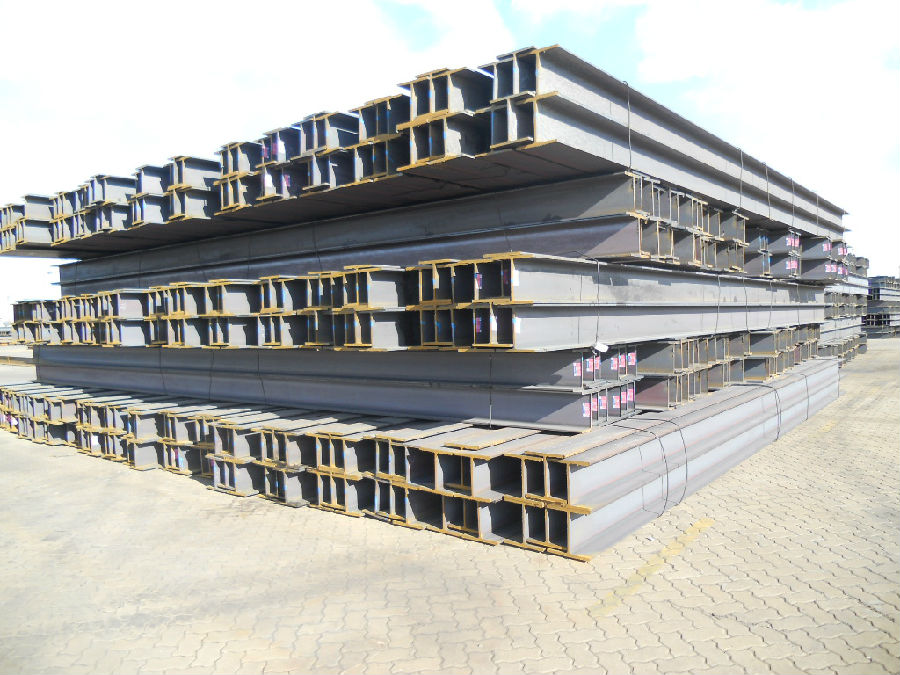

- Q:Can steel H-beams be used for industrial structures?
- Yes, steel H-beams can be used for industrial structures. H-beams offer great strength and durability, making them suitable for supporting heavy loads and withstanding various environmental conditions. They are commonly used in construction projects for warehouses, factories, and other industrial facilities.
- Q:Are Steel H-Beams resistant to termite or insect damage?
- Steel H-beams are resistant to termite or insect damage. They differ from wooden beams in that they do not offer a source of nourishment for termites or other insects, thus making them highly resistant to infestation. Through the combination of iron and carbon, steel beams are created, which do not allure or sustain termite colonies. This resistance to termite or insect damage serves as one of the numerous benefits of incorporating steel H-beams into construction projects, guaranteeing the beams' structural solidity and long lifespan.
- Q:Are steel H-beams suitable for use in the construction of correctional facilities or prisons?
- Certainly, steel H-beams are an appropriate option for the construction of correctional facilities or prisons. Due to their exceptional strength and durability, steel H-beams are widely used in the construction industry. These beams provide structural support and stability, making them perfect for the construction of secure and sturdy correctional facilities. One of the main necessities for correctional facilities is the ability to endure extreme conditions and resist potential threats. Steel H-beams are specifically designed to handle heavy loads and resist bending or warping, ensuring the facility's structural integrity. They can withstand high winds, earthquakes, and other natural disasters, making them a dependable choice for correctional facilities located in various areas. Furthermore, steel H-beams offer great flexibility in design and construction. They can be customized to meet specific project requirements and easily integrated with other building materials. This allows architects and engineers to design secure facilities that comply with safety standards and accommodate the unique needs of correctional facilities, such as high-security areas and specialized confinement spaces. Moreover, steel H-beams are fire-resistant, a crucial characteristic for correctional facilities where fire safety is a top priority. Steel does not burn or contribute to the spread of fire, providing an additional level of safety for both inmates and staff. Additionally, steel H-beams require minimal maintenance, reducing long-term costs associated with repairs and replacements. All in all, steel H-beams are a suitable choice for the construction of correctional facilities or prisons. Their strength, durability, versatility, and fire-resistant properties make them an ideal material for creating secure and robust structures that can withstand the demanding and high-security requirements of correctional facilities.
- Q:What are the design considerations for steel H-beams in coastal areas?
- When designing steel H-beams for coastal areas, there are several important considerations that need to be taken into account. These considerations are primarily aimed at ensuring the durability and longevity of the H-beams in the corrosive and harsh coastal environment. 1. Corrosion resistance: Coastal areas are exposed to high levels of saltwater and humidity, which can accelerate the corrosion process. Therefore, it is crucial to select steel with excellent corrosion-resistant properties, such as stainless steel or galvanized steel. These materials have protective coatings that can withstand the corrosive nature of the coastal environment. 2. Coastal winds and storms: Coastal regions often experience strong winds and storms, which can exert significant forces on the H-beams. Designers should consider the wind load and ensure that the H-beams are adequately sized and reinforced to withstand these forces. Additionally, proper connections and fasteners should be used to ensure the structural integrity of the H-beams during extreme weather events. 3. Erosion and scour: Coastal areas are prone to erosion and scour, which can undermine the stability of the H-beams. To mitigate this risk, it is important to consider the soil conditions and design appropriate foundations for the H-beams. Measures such as using additional piling or protective barriers can also be implemented to prevent erosion and scour around the H-beams. 4. Maintenance and inspection: Due to the harsh coastal environment, regular maintenance and inspection are essential for steel H-beams. This includes periodic cleaning, repainting, and inspection for signs of corrosion or damage. Implementing a maintenance plan and ensuring that it is followed diligently will help extend the lifespan of the H-beams in coastal areas. 5. Environmental considerations: Coastal areas are often environmentally sensitive, with unique ecosystems and wildlife habitats. Designers should consider the potential impact of the H-beams on the environment and incorporate measures to minimize disruption. This can include using environmentally friendly coatings, avoiding sensitive areas, or implementing mitigation measures such as bird deterrents. In summary, when designing steel H-beams for coastal areas, considerations such as corrosion resistance, wind load, erosion and scour, maintenance and inspection, and environmental impact should all be taken into account. By addressing these factors, engineers can ensure the durability and resilience of the H-beams in the challenging coastal environment.
- Q:What are the considerations for designing with steel H-beams?
- When designing with steel H-beams, there are several important considerations to keep in mind. First and foremost, it is essential to understand the load-bearing capacity of the H-beams. This includes determining the maximum weight that the beams can support and ensuring that the design factors in any potential dynamic or live loads that may be applied. Calculating the required strength of the beams can be done through structural analysis and design calculations, taking into account factors such as the span length, beam size, and material properties. Another consideration is the overall structural stability and rigidity of the H-beam design. H-beams are known for their high strength-to-weight ratio, but they can also be susceptible to lateral torsional buckling under certain conditions. It is important to analyze and design for these potential stability issues to ensure the safety and integrity of the structure. This may involve adding additional bracing or stiffeners to the H-beams to enhance their stability. Connection detailing is also a crucial aspect of designing with steel H-beams. The connections between the H-beams and other structural members, such as columns or beams, need to be carefully designed to ensure proper load transfer and structural continuity. The type of connection, whether it be bolted, welded, or a combination of both, should be selected based on factors such as the expected loads, construction constraints, and the desired level of structural flexibility. Fire resistance is another consideration when designing with steel H-beams. Steel is inherently fire-resistant, but it can lose its strength and stiffness when subjected to high temperatures for extended periods. Therefore, it is important to consider fire protection measures, such as fireproof coatings or the use of fire-resistant materials, to ensure the structural integrity of the H-beams in the event of a fire. Lastly, the cost and availability of steel H-beams should be taken into account during the design process. The size, grade, and quantity of H-beams required for the project may have an impact on the overall cost and feasibility of the design. Additionally, it is important to consider the availability of the required H-beams in the market to avoid potential delays or cost overruns. In conclusion, designing with steel H-beams requires careful consideration of load-bearing capacity, structural stability, connection detailing, fire resistance, and cost considerations. By addressing these factors, a well-designed H-beam structure can be achieved that meets the required performance criteria and ensures the safety and durability of the project.
- Q:Can steel H-beams be used for museums or cultural centers?
- Yes, steel H-beams can be used for museums or cultural centers. Steel H-beams offer structural strength and durability, making them suitable for supporting large spans and heavy loads. They can be used in the construction of exhibition halls, galleries, and other areas within museums or cultural centers. Additionally, the versatility of steel allows for creative architectural designs that can enhance the aesthetic appeal of these spaces, while ensuring the safety and stability of the structure.
- Q:How do steel H-beams perform in areas with high levels of humidity or moisture?
- Steel H-beams perform well in areas with high levels of humidity or moisture. Due to their inherent strength and durability, steel H-beams are resistant to corrosion and rust formation, even in humid environments. This is primarily due to the protective coating, such as galvanization or epoxy paint, applied to the steel surface, which acts as a barrier against moisture and prevents the steel from coming into direct contact with the humid air. Additionally, the design of H-beams allows for efficient drainage of any accumulated water, further enhancing their performance in wet conditions. Therefore, steel H-beams are suitable and reliable for use in areas with high levels of humidity or moisture.
- Q:Can steel H-beams be used in the construction of museums and art galleries?
- Certainly, museums and art galleries can indeed utilize steel H-beams in their construction. Renowned for their robustness and longevity, steel H-beams possess the capability to bear substantial loads and endure structural strains, rendering them suitable for this purpose. These beams offer exceptional structural support, facilitating the creation of spacious areas and flexible layouts within the museum or art gallery. Additionally, steel H-beams can be tailored to various dimensions and lengths, providing flexibility in terms of design and construction. Furthermore, the sleek and contemporary appearance of steel beams can harmonize with the overall architectural style and design of the museum or art gallery. Overall, owing to their strength, durability, and versatility, steel H-beams are widely favored within the construction industry as an ideal material for museums and art galleries.
- Q:How do steel H-beams contribute to sustainable infrastructure?
- Steel H-beams contribute to sustainable infrastructure in several ways. Firstly, steel is a highly durable and long-lasting material, meaning that structures built with steel H-beams will have a longer lifespan compared to other materials. This reduces the need for frequent repairs or replacements, resulting in less waste and resource consumption over time. Additionally, steel is a highly recyclable material, with a high recycling rate. This means that at the end of a structure's life, the steel H-beams can be easily recycled and repurposed, reducing the demand for new steel production and minimizing environmental impact. Furthermore, steel H-beams offer exceptional strength-to-weight ratio, allowing for lighter and more efficient designs. This results in reduced material usage, less energy consumption during construction, and lower carbon emissions associated with transportation and installation. Overall, the use of steel H-beams in infrastructure projects promotes sustainability by enhancing durability, recyclability, and efficiency, ultimately contributing to longer-lasting, environmentally-friendly structures.
- Q:How do steel H-beams contribute to natural ventilation in buildings?
- A significant role in enhancing natural ventilation in buildings is played by steel H-beams. Their contribution to natural ventilation is through the provision of structural support for large openings such as windows, doors, and skylights. These openings allow for the free flow of air into and out of the building. Typically, H-beams are used in the construction of building frames, where they serve as the main structural elements that bear the weight of the building. Their design enables the creation of wide-span openings, strategically positioned to maximize airflow and ventilation. Incorporating these large openings into the building's design facilitates the intake of fresh air from the outside. This fresh air displaces stale indoor air, resulting in a natural circulation that helps maintain a healthy and comfortable indoor environment. Furthermore, steel H-beams can support various ventilation systems like louvers, vents, and exhaust fans. These systems can be integrated into the openings created by the H-beams, further enhancing the airflow and improving natural ventilation. Steel H-beams also contribute to natural ventilation by allowing for the installation of shading devices such as sunshades or awnings. These devices can be attached to the H-beams, providing shade from direct sunlight while still allowing air to pass through. This reduces solar heat gain and helps maintain a comfortable indoor temperature without relying heavily on mechanical cooling systems. In conclusion, steel H-beams enhance natural ventilation in buildings by providing structural support for large openings, facilitating the intake and circulation of fresh air, accommodating various ventilation systems, and allowing for the installation of shading devices. These features improve indoor air quality, reduce energy consumption, and create a more sustainable and comfortable built environment.
1. Manufacturer Overview |
|
|---|---|
| Location | |
| Year Established | |
| Annual Output Value | |
| Main Markets | |
| Company Certifications | |
2. Manufacturer Certificates |
|
|---|---|
| a) Certification Name | |
| Range | |
| Reference | |
| Validity Period | |
3. Manufacturer Capability |
|
|---|---|
| a)Trade Capacity | |
| Nearest Port | |
| Export Percentage | |
| No.of Employees in Trade Department | |
| Language Spoken: | |
| b)Factory Information | |
| Factory Size: | |
| No. of Production Lines | |
| Contract Manufacturing | |
| Product Price Range | |
Send your message to us
Hot Rolled Structual Carbon JIS Steel H-beam Bar
- Loading Port:
- China main port
- Payment Terms:
- TT or LC
- Min Order Qty:
- 25 m.t.
- Supply Capability:
- 1000 m.t./month
OKorder Service Pledge
OKorder Financial Service
Similar products
New products
Hot products
Related keywords
